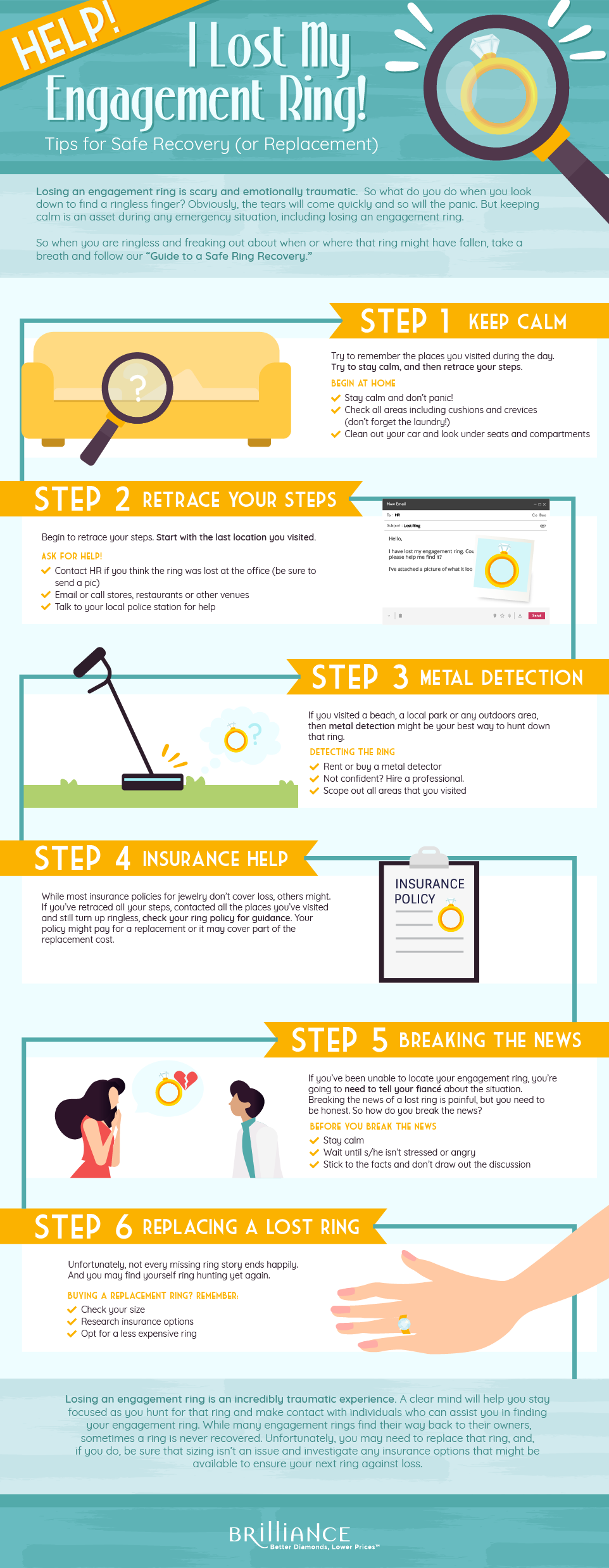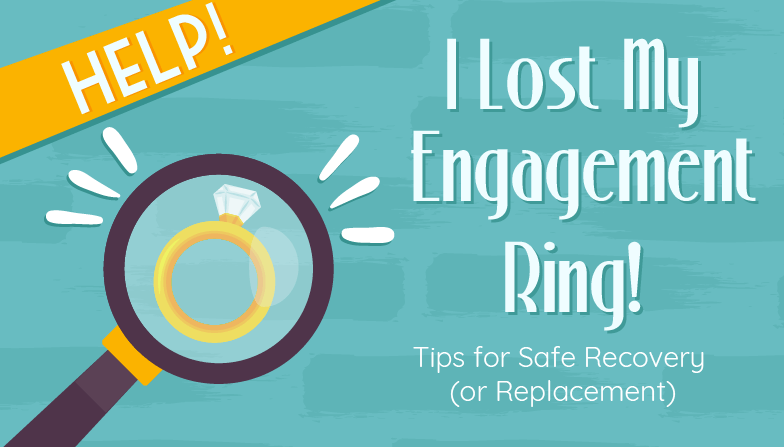Getting engaged is one of the most exciting moments in a couple’s life. For many women and men, the engagement ring is the icing on the wedding cake, and showing off the new ring, posting ring selfies, and, let’s face it, spending moments just gazing at that brand new ring are all part of the joy and bliss of saying “yes!” But sometimes that bliss comes crashing down in an instant when that loving hand gaze turns to sheer horror at the discovery of a missing ring!
Losing an engagement ring is scary and emotionally traumatic. As the average price of an engagement ring is around $5,700, losing that bling isn’t just a heartbreaking moment but also a financially devastating one as well. So what do you do when you look down to find a ringless finger? Obviously, the tears will come quickly and so will the panic. But keeping calm is an asset during any emergency situation, including losing an engagement ring.
Forget zombie apocalypse, because hunting down a lost engagement ring is a real lesson in disaster prep! So when you are ringless and freaking out about when or where that ring might have fallen, take a breath and follow our “Guide to a Safe Ring Recovery.”
Step One: Keep Calm
Yes, your first instinct might be tears, and that’s perfectly fine. But you need to take a deep breath and keep calm. Hunting down your ring requires a clear and focused mind, because you need to think back to the last time you remember seeing that ring on your hand. Did you put the ring on in the morning? Did you take a ring selfie or any selfie showing that ring throughout the day? Do you remember putting on your ring? Some individuals take their ring off before bedtime and put it back on in the morning. It’s important to think back to try to remember the last time you noticed the ring on your hand.
If you wore your ring all day or you distinctly remember putting it on, you need to think back to the tasks of your day. Where were you and what were you doing during the day? Some tasks put us at a higher risk of a piece of jewelry slipping off. Washing your hands, doing the dishes or cleaning all could contribute to slippery fingers and a looser ring.
Try to remember the places you visited during the day. Try to stay calm, and then retrace your steps. The best way to do this is to work backward as if you are rewinding your day. Look around your current location, which is probably your home. Go to your car and see if it might have slipped off and fallen under a seat. Check couch cushions and dig through your laundry piles. Sometimes rings come off when we change clothes.
Begin at home
- Stay calm and don’t panic!
- Check all areas including cushions and crevices (don’t forget the laundry!)
- Clean out your car and look under seats and compartments
Step Two: Retrace Your Steps
If your current location has been scoped up and down and your ring is still MIA, then you need to begin to retrace your steps. Start with the last location you visited. If this was your work or office, head there and look around. Send an email to a supervisor or HR and explain that you’re missing your ring; be sure to include a picture.
For restaurants, museums and stores, call and inquire about your lost engagement ring. You’ll likely need to send them a description or a photo of the ring. Many individuals also contact their local police department for assistance in filing a report; many well meaning citizens drop off valuable jewelry at a local law enforcement office. So it never hurts to check in with your local police department.
Ask for help!
- Contact HR if you think the ring was lost at the office (be sure to send a pic)
- Email or call stores, restaurants or other venues
- Talk to your local police station for help
Step 3: Metal Detection
Stores, restaurants and other places of business won’t be too happy with you bringing in a metal detector to hunt for your ring. If they find it, they should let you know. However, if you visited a beach, a local park or any outdoors area, then metal detection might be your best way to hunt down that ring.
According to MetalDetector.com, most metal detectors can pinpoint platinum, gold, silver and bronze jewelry. Don’t have a metal detector? There are many individuals who work to find rings, and you can find assistance through a directory offered by The Ring Finders Metal Detecting Service, Inc. You may also be able to rent a metal detector through a local store.
Remember that when you use a metal detector you may find more than you were looking for, and you may stumble upon other rings, bracelets or other tokens during your hunt.
Detecting the ring
- Rent or buy a metal detector
- Not confident? Hire a professional.
- Scope out all areas that you visited
Step 4: Insurance Help
While most insurance policies for jewelry don’t cover loss, others might. If you’ve retraced all your steps, contacted all the places you’ve visited and still turn up ringless, check your ring policy for guidance. Your policy might pay for a replacement or it may cover part of the replacement cost. If you can’t find a copy of your policy, contact your provider and inquire about loss coverage.
Step 5: Breaking the News
If you’ve been unable to locate your engagement ring, you’re going to need to tell your fiancé about the situation. Breaking the news of a lost ring is painful, but you need to be honest. So how do you break the news?
Don’t tell your fiancé during a stressful time like after he or she comes home from work. Wait for down time, and be sure your fiancé isn’t super stressed or angry when you sit down for the conversation. Deliver the news like ripping off a band-aid, don’t sugar coat the situation, don’t beat around the bush. Be calm, be gentle and let your fiancé know all the steps that you’ve taken—or are taking—to recover the lost ring. Your fiancé also might have suggestions on what to do next.
Before you break the news
- Stay calm
- Wait until s/he isn’t stressed or angry
- Stick to the facts and don’t draw out the discussion
Step 6: Replacing a Lost Ring
Sometimes even all the metal detection in the world might not be able to retrieve your ring. It might have fallen in a lake, the ocean or somewhere out of reach. Or someone might have picked it up and kept it dishonestly. Unfortunately, not every missing ring story ends happily. And you may find yourself ring hunting yet again.
If you do end up back at the jewelry store or shopping online, be cautious when selecting a new ring. Make sure your sizing is accurate and always research ring insurance policies that might cover loss. Protect your future asset and be sure that you invest wisely.
Buying a replacement ring? Remember:
- Check your size
- Research insurance options
- Opt for a less expensive ring
How to avoid losing that ring in the first place?
You may never know how your ring fell off, but there are risk factors that can make loss more likely. Size matters with any ring, and while you need to be able to take off your ring, it should never slip off easily. Cold weather shrinks our hands, and a ring that doesn’t fit snugly risks falling off when the temps drop.
Work with your jeweler to find your proper ring size and fit. If your finger is between sizes and nothing fits well, then investigate options to tighten the band. Jewelers can place little beads inside the band to tighten the fit on the finger. Or you may even use a piece of metal that makes the ring smaller. Ill-fitting rings are at risk for loss, and this is one aspect you CAN control.
Hand-washing, showering or swimming can also loosen a ring. Use hot water when washing hands to avoid finger shrinkage and looser rings. And never EVER swim, shower or bathe with your rings on. Instead, take them off at home and store them in a jewelry box.
Certain chemicals and soaps can also make fingers and rings slippery. Take off rings when cleaning the house or when using any soaps and chemicals. Not only will this keep your ring from slipping off, but those chemicals could also damage or warp the metal or gemstones. Again, store your rings somewhere safe when cleaning.
If you’re headed to the gym or are out for a run, you can also use a ring protector that covers your ring. This is a wide band of rubber or silicone that is placed over your engagement ring to keep it snug and secure. These helpful accessories can be found in many colors and different sizes. Of course, the safest way to protect your ring at the gym is to not wear it during your workout, but last-minute workouts happen and ring covers are a simple solution.
Losing an engagement ring is an incredibly traumatic experience. While your first reaction may be complete panic, you need to stay calm and be in control. A clear mind will help you stay focused as you hunt for that ring and make contact with individuals who can assist you in finding your engagement ring. Retrace your steps, contact all the businesses you visited, use a metal detector to scope out beaches and parks and investigate possible loss coverage through a jewelry insurance policy. While many engagement rings find their way back to their owners, sometimes a ring is never recovered. Unfortunately, you may need to replace that ring, and, if you do, be sure that sizing isn’t an issue and investigate any insurance options that might be available to ensure your next ring against loss.




